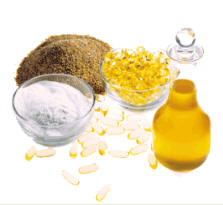Natural Non-Drug Remedies for Inflammation

By Jack Challem
Copyright 2000 by Jack Challem, The
Nutrition Reporter™
All rights reserved. This article originally
appeared in Let's Live magazine.
For more information contact jack@stopinflammation.com
With the fanfare of a holiday parade, drug companies last year unveiled two new Cox-2 inhibitor drugs - Celebrex and Vioxx - to treat arthritis, inflammation, premenstrual syndrome, and potentially even cancer. All the hoopla paid off. Since then, doctors have written more than seven million prescriptions for these "super aspirin" drugs, earning hundreds of million dollars for their makers.
Cox-2 is short for cyclooxygenase-2, one of the key enzymes that helps the body produce inflammatory hormone-like compounds called prostaglandins and cytokines. Cox-2 is essential - without it, we wouldn't be able to fight infections or heal injuries. But when the body overproduces Cox-2, the result is chronic inflammation and pain.
The intensive marketing and advertising of Cox-2 inhibitors obscured why many people overproduce the enzyme. Too much Cox-2 appears to result from imbalances and deficiencies of certain nutrients. Rather than correct these underlying dietary problems, pharmaceutical Cox 2 inhibitors only mask the most visible symptoms. Relatively minor dietary changes, plus some vitamin and herbal supplements, correct the underlying problems.
Problems with Cox-2 Inhibitor Drugs
For years, people have used nonsteroidal antiinflammatory drugs (NSAIDS), such as ibuprofen, to treat the inflammation and pain associated with rheumatoid arthritis and osteoarthritis. NSAIDS ease inflammation by inhibiting the activity of both Cox-2 and Cox-1, the latter an enzyme that helps maintain homeostasis (biological equilibrium) protect the stomach lining. Because stomach ulcers occur in about 25 percent of NSAID users, pharmaceutical companies worked to develop NSAIDS that blocked only the activity of Cox-2. The idea was that a selective Cox-2 inhibitor would reduce inflammation but not irritate the stomach.
The motivation was profiting from a potentially huge market. An estimated 40 million Americans suffer from some form of arthritis. In a typical year, physicians write about 60 million prescriptions for NSAIDS - to say nothing of their over-the-counter sales. However, each year some half-million people develop complications from NSAIDS, with an estimated 80,000 people requiring hospitalization and 8,000 dying.
Though touted for their relative safety, Cox-2 inhibitors may be far more hazardous than originally believed. While gastrointestinal problems with Cox-2 inhibitors occur less frequently, they can be severe. Just four months after the FDA approved Celebrex, 10 deaths from the drug were reported. One study has even suggested that Cox-2 is important to the gut and healing ulcers, suggesting that pharmaceutical tampering with the enzyme may not be wise.Nutrients supply the most basic building blocks of the body's powerful inflammatory compounds. The "parent" nutrient is linoleic acid, found in many foods but especially concentrated in vegetable oils (e.g., corn, soy, and safflower oils). The body converts linoleic acid to the omega-6 family of fatty acids, including arachidonic acid. Cox-2 plays a critical role in converting arachidonic acid to the hormone-like prostaglandin E2 (PGE2) and to the cytokines interleukin-1 (IL-1), interleukin-6 (IL-6), and tumor necrosis factor alpha (TNFa), all of which promote inflammation.
According to Robert F. Grimble, Ph.D., of the University of Southampton, England, once an infection or injury stimulates production of IL-1 and TNFa, these two proinflammatory compounds can further stimulate each other, as well as IL-6. In addition, IL-1 and TNFa trigger the production of free radicals, which encourage the production of more proinflammatory cytokines. The proinflammatory reaction essentially feeds on itself, setting the stage for chronic inflammation.
Ideally, the body balances these compounds with a group of antiinflammatory compounds that originate with alpha-linolenic acid, found in cold-water fish, leafy green vegetables, and flaxseed. The body converts alpha-linolenic acid to the omega-3 family of fatty acids, which include eicosapentaenoic acid (EPA) and docosahexaenoic acid (DHA). Preformed EPA and DHA are also found in cold-water fish.
Much of the problem with inflammatory disorders actually stems from a lopsided imbalance in dietary intake of the omega-6 and omega-3 fatty acids - and the consequential cascade in proinflammatory activity. Artemis Simopolous, M.D., director of the Center for Genetics, Nutrition and Health in Washington, D.C., has shown that people historically consumed roughly equal amounts of the proinflammatory omega-6 fatty acids and the antiinflammatory omega-3 fatty acids.
However, over the past 30 years or so, Americans have replaced much of their dietary saturated fat (a bystander, so far as inflammation is concerned) with omega-6 fatty acids. Simopoulos estimates that people are now eating 20 times more omega-6s than omega-3s. From a biochemical standpoint, this sets the stage for powerful and chronic proinflammatory reactions.
Indeed, inflammation plays a role in many diseases, including arthritis, gingivitis and most of "-itis" diseases. Recent research has pointed to the role of inflammation in heart disease, stroke, and even Alzheimer's disease. In addition, Bruce N. Ames, Ph.D., of the University of California, Berkeley, has estimated that chronic inflammation and infection cause about one third of all cancers.
This relationship between diet, inflammation, and cancer was recently demonstrated by researchers at the American Health Foundation, Valhalla, New York. In animal experiments, they noted that corn oil (rich in omega-6) increased Cox-2 activity, whereas fish oil (rich in omega-3) blunted Cox-2 activity. The researchers also showed that the omega-6 fatty acids could promote the growth of colon cancer, whereas the omega-3 fatty acids prevented cancer.
In addition to a diet containing too many omega-6 fatty acids, a shortage of nutritional antioxidants, such as vitamin E, also contributes to chronic inflammation. The proinflammatory cytokines, IL-1 and TNFa, trigger the release of free radicals. A diet rich in antioxidants - found chiefly in vegetables and fruit - can help neutralize these free radicals. But relatively few people - 9 to 34 percent, according to different researchers - eat the recommended five daily servings of vegetables and fruit. Between an excess omega-6 fatty acids and a lack of omega-3 fatty acids, and inadequate intake of antioxidants, the body's proinflammatory reaction goes out of control, leading to chronic inflammation and pain.
Quenching the Fires of Inflammation
The simplest and most biochemically sound way of turning down the body's proinflammatory prostaglandins and cytokines is by restoring a balance between pro- and antiinflammatory foods. From a dietary standpoint, this means switching from vegetable oils to extra-virgin olive oil (high in antiinflammatory omega-9 fatty acids). It also means avoiding most processed (boxed, canned, or frozen) foods, because their makers frequently add omega-6 fatty acids. By eating simple unprocessed foods - such as baked chicken, a salad, and steamed vegetables - it becomes easier to consume a more balanced ratio of omega-6 and omega-3 fatty acids.
However, if you're like most people, you've been eating a diet high in omega-6 fatty acids and low in antioxidants for years. Simply restoring a balance is not enough to quickly offset accumulated damage, because the fatty acid composition of the body's cells reflects their dietary ratios. It's imperative to increase consumption of antiinflammatory fatty acids and antioxidants.These are the supplements to emphasize:
·
Omega-3 essential fatty acids. Found in fish oils, EPA and DHA are essential building blocks for the body's antiinflammatory prostaglandins (e.g., prostaglandin E1) and for turning off Cox-2 and the body's proinflammatory cytokines(IL-1, IL-6, and TNFa). In addition, omega-3 fatty acids block the activity of an enzyme that breaks down joint cartilage. Daily dosage: 3 or more grams.
·
Gamma-linolenic acid. Although GLA is an omega-6 fatty acid, it has antiinflammatory properties. Relatively little GLA is converted to arachidonic acid and prostaglandin E2. Instead, GLA increases production of the antiinflammatory prostaglandin E1. Robert B. Zurier, M.D., of the University of Massachusetts Medical Center, Worcester, gave GLA supplements or placebos to 41 patients with rheumatoid arthritis. Two-thirds of those receiving GLA had a 25 percent reduction in their arthritic symptoms. Daily dosage: 2-3 grams.·
Vitamin E. Although Cox-2 and prostaglandin E2 levels rise with age, animal studies have shown that vitamin E supplements reverse the increase in Cox-2 and prostaglandin E2. Vitamin E also turns off nuclear factor-kB (NF-kB) and activator protein-1 (AP-1), compounds that turn on inflammatory genes. One recent study found that arthritics taking supplements of natural vitamin E (600 mg twice daily) for 12 weeks had their pain reduced by about half. Daily dosage: 400-800 IU.·
Vitamin C. Long recognized for its antiinflammatory properties, the effects of vitamin C are enhanced by other nutrients. In a study of people exposed to simulated sunlight, researchers found that vitamin C and E worked synergistically to reduce skin inflammation. In a cell study, Italian researchers noted that quercetin and vitamin C worked together to protect cells from inflammation-induced damage. Daily dosage: 1,000-2,000 mg.·
Polyphenols and Flavonoids. Researchers at Case Western Reserve University, Cleveland, recently reported that the antioxidant polyphenols in green tea had antiinflammatory properties by inhibiting Cox-2 and TNFa. Genistein inhibits prostaglandin E2 and Cox-2, and quercetin inhibits the activity of inflammation-promoting "adhesion" molecules. It's likely that Pycnogenol, grape seed extract, and other flavonoids work through similar mechanisms. Daily dosage: 25-500 mg.·
St. John's wort. Better known for its antidepressant effect, this herb also has antiinflammatory properties. In a laboratory experiment, researchers from the University of Frieburg, Germany found that hypericin, one of the constituents of St. John's wort, inhibited NF-kB, which activates proinflammatory genes. Daily dosage: Because product forms vary, follow label directions.·
Silymarin. A cell-culture study found that silymarin, the antioxidant extract of milk thistle, inhibited Cox-2 formation. This role of silymarin may partly explain why earlier cell-culture studies found it to inhibit the growth of prostate, breast, and skin cancers. Daily dosage: 100 200 mg.·
Ginger. With a long history as a folk medicine, ginger inhibits Cox-2 and another proinflammatory compound, 5-lipoxygenase. This simple herb and condiment contains almost 500 different compounds, many of which are antiinflammatory, according to Thomas M. Newmark and Paul Shulick, authors of Beyond Aspirin: Nature's Answer to Arthritis, Cancer & Alzheimer's Disease (Holm Press, Prescott, Arizona, 2000). Daily dosage: 100 mg.·
Rosemary. This common kitchen herb is rich in ursolic acid and many of its derivatives. In laboratory experiments, Swedish researchers found that the ursolic acid extract of rosemary was a potent inhibitor of Cox-2 activity. Daily dosage: 100 mg.·
Curcumin. A natural pigment that accounts for the yellow color of the spice turmeric, curcumin is also a powerful antioxidant. A recent cell study by researchers at Cornell University, New York, found that curcumin blocked the activity of Cox-2. The researchers suggested that this property might explain some of the herb's anticancer effects. Daily dosage: 2.8 mg.·
Cat's Claw. Known as una de gato and Uncaria tomentosa, this Peruvian herb has a long history as a remedy for inflammatory arthritis. Recent cell-culture and animal experiments at the Albany Medical College, New York, found that cat's claw inhibited inflammation by blocking the activity of NF-kB. Daily dosage: Because products vary, follow label directions.
The take home message in all this is
relatively simple: pharmaceutical drugs,
while providing rapid relief of symptoms, do
not correct the underlying cause of chronic
inflammation. The cause of frequently a diet
that's either unbalanced or lacking in key
nutrients. No drug can correct a nutritional
deficiency or imbalance. Only nutrients can
do that.


